Prediction of Sexual Risk Behaviors in College Students Report
VerifiedAdded on 2019/12/03
|10
|2790
|185
Report
AI Summary
This report presents a critical analysis of a research article that investigates the prediction of sexual risk behaviors in college students using the Theory of Planned Behavior (TPB). The study, conducted by Jessica and Christine (2013), explores how factors like intentions, attitudes, subjective norms, and perceived behavioral control influence behaviors such as condom use, contraceptive use, and engagement in casual sex. The report provides an overview of the article, discussing the TPB model and its application to understanding risky sexual activities, particularly in relation to substance use. The critical review examines the study's methodology, including data collection from a sample of undergraduate students and the use of structural equations modeling. The report also highlights the limitations of the study, such as the use of a convenience sample and self-report surveys, while emphasizing the importance of understanding the relationship between intentions and actual behavior in predicting sexual risk-taking. The report concludes by summarizing the key findings and implications of the study, emphasizing the need for further research and interventions to reduce risky sexual behaviors on college campuses. This report is a valuable resource for students seeking to understand the complexities of sexual health and behavior.
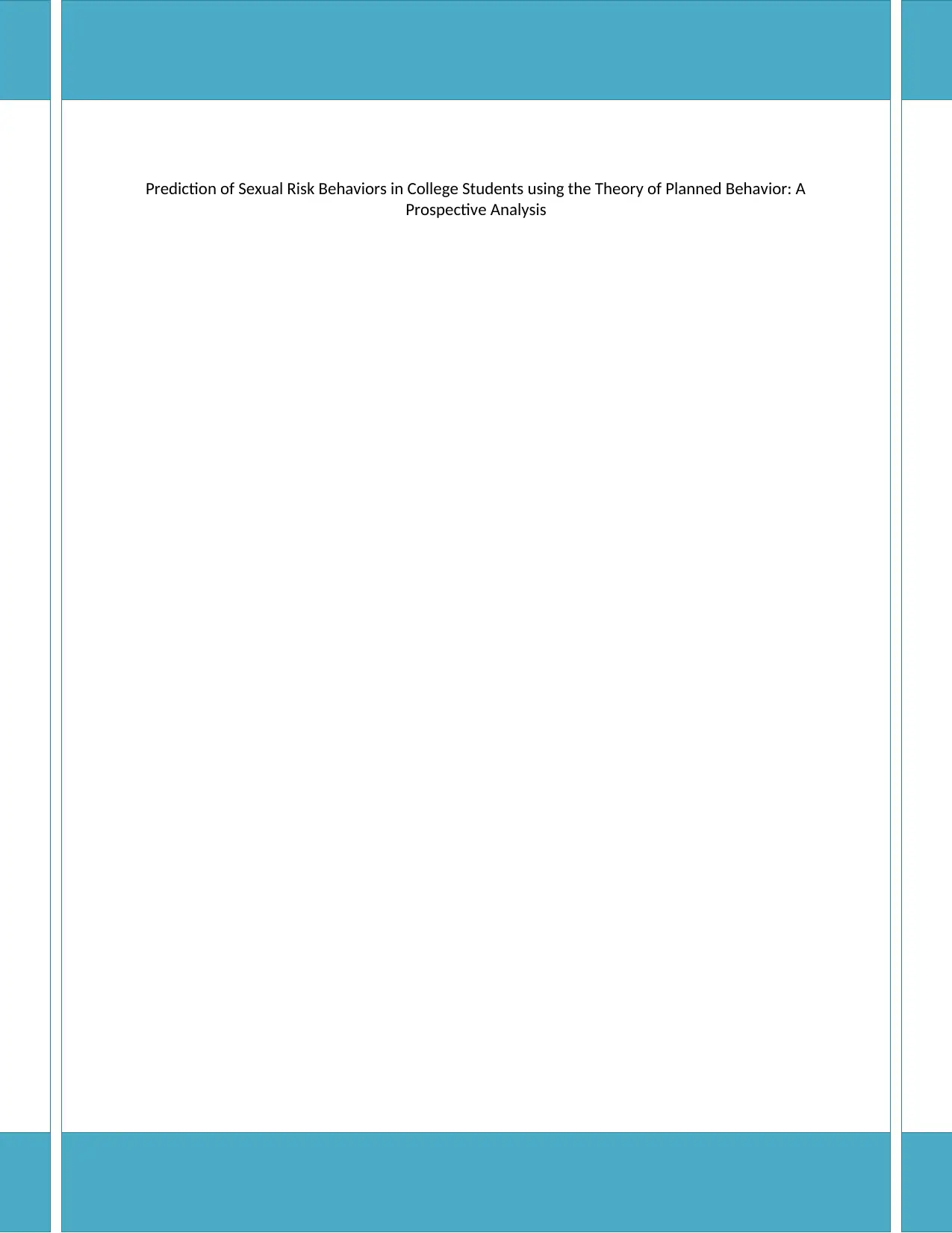
Prediction of Sexual Risk Behaviors in College Students using the Theory of Planned Behavior: A
Prospective Analysis
Prospective Analysis
Paraphrase This Document
Need a fresh take? Get an instant paraphrase of this document with our AI Paraphraser
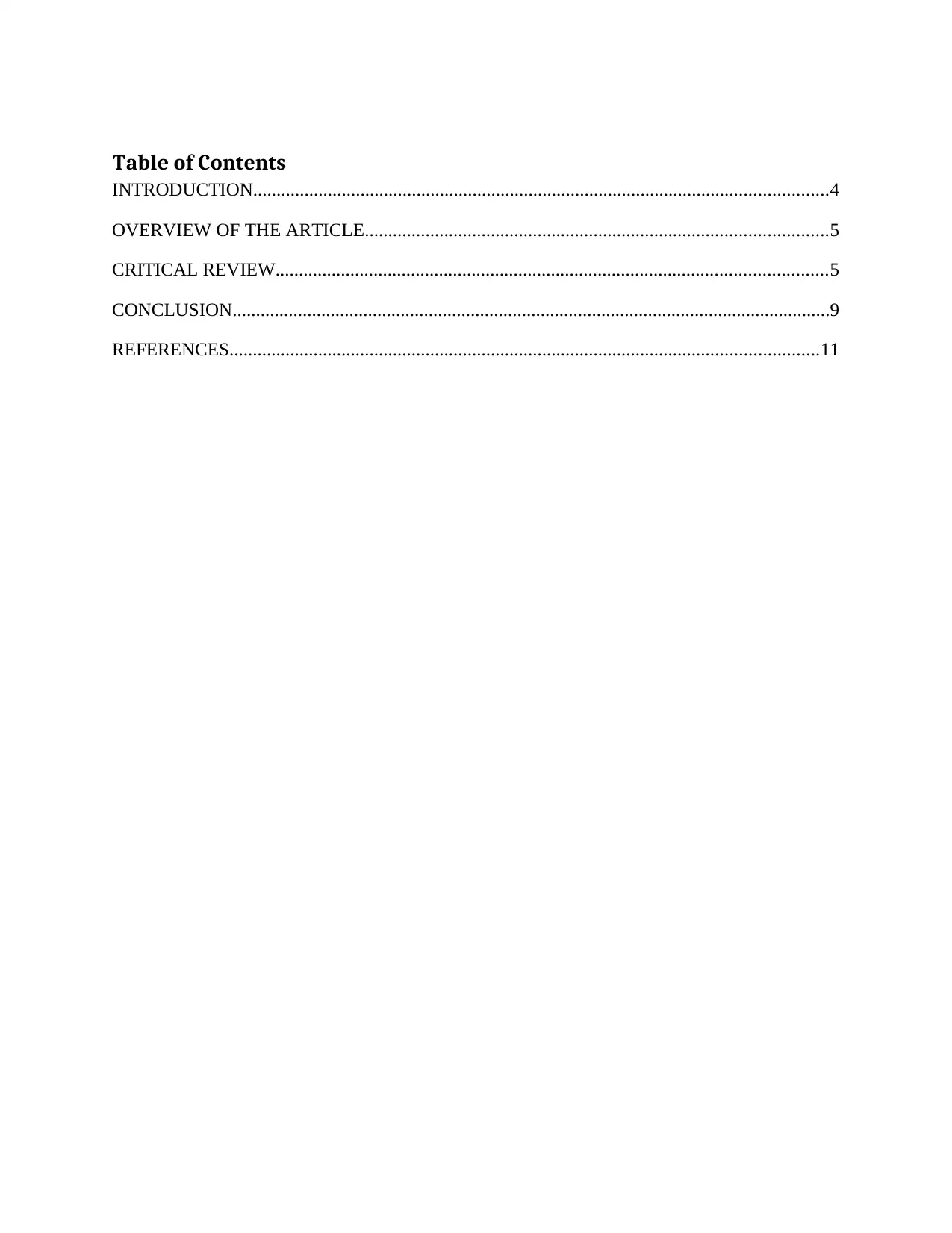
Table of Contents
INTRODUCTION...........................................................................................................................4
OVERVIEW OF THE ARTICLE...................................................................................................5
CRITICAL REVIEW......................................................................................................................5
CONCLUSION................................................................................................................................9
REFERENCES..............................................................................................................................11
INTRODUCTION...........................................................................................................................4
OVERVIEW OF THE ARTICLE...................................................................................................5
CRITICAL REVIEW......................................................................................................................5
CONCLUSION................................................................................................................................9
REFERENCES..............................................................................................................................11

List of Figures
Figure 1: theory of planned behavior...............................................................................................5
Figure 1: theory of planned behavior...............................................................................................5
⊘ This is a preview!⊘
Do you want full access?
Subscribe today to unlock all pages.

Trusted by 1+ million students worldwide
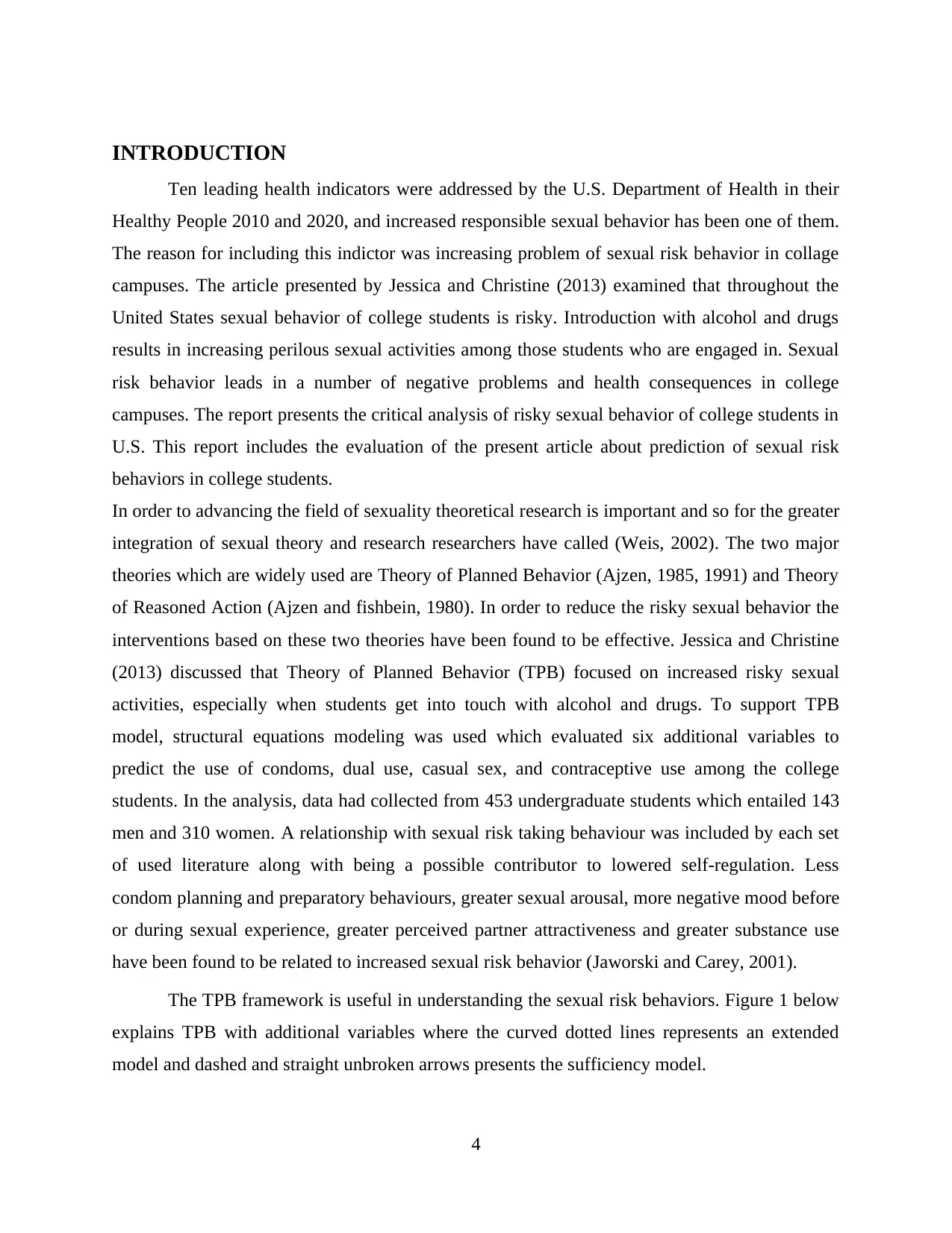
INTRODUCTION
Ten leading health indicators were addressed by the U.S. Department of Health in their
Healthy People 2010 and 2020, and increased responsible sexual behavior has been one of them.
The reason for including this indictor was increasing problem of sexual risk behavior in collage
campuses. The article presented by Jessica and Christine (2013) examined that throughout the
United States sexual behavior of college students is risky. Introduction with alcohol and drugs
results in increasing perilous sexual activities among those students who are engaged in. Sexual
risk behavior leads in a number of negative problems and health consequences in college
campuses. The report presents the critical analysis of risky sexual behavior of college students in
U.S. This report includes the evaluation of the present article about prediction of sexual risk
behaviors in college students.
In order to advancing the field of sexuality theoretical research is important and so for the greater
integration of sexual theory and research researchers have called (Weis, 2002). The two major
theories which are widely used are Theory of Planned Behavior (Ajzen, 1985, 1991) and Theory
of Reasoned Action (Ajzen and fishbein, 1980). In order to reduce the risky sexual behavior the
interventions based on these two theories have been found to be effective. Jessica and Christine
(2013) discussed that Theory of Planned Behavior (TPB) focused on increased risky sexual
activities, especially when students get into touch with alcohol and drugs. To support TPB
model, structural equations modeling was used which evaluated six additional variables to
predict the use of condoms, dual use, casual sex, and contraceptive use among the college
students. In the analysis, data had collected from 453 undergraduate students which entailed 143
men and 310 women. A relationship with sexual risk taking behaviour was included by each set
of used literature along with being a possible contributor to lowered self-regulation. Less
condom planning and preparatory behaviours, greater sexual arousal, more negative mood before
or during sexual experience, greater perceived partner attractiveness and greater substance use
have been found to be related to increased sexual risk behavior (Jaworski and Carey, 2001).
The TPB framework is useful in understanding the sexual risk behaviors. Figure 1 below
explains TPB with additional variables where the curved dotted lines represents an extended
model and dashed and straight unbroken arrows presents the sufficiency model.
4
Ten leading health indicators were addressed by the U.S. Department of Health in their
Healthy People 2010 and 2020, and increased responsible sexual behavior has been one of them.
The reason for including this indictor was increasing problem of sexual risk behavior in collage
campuses. The article presented by Jessica and Christine (2013) examined that throughout the
United States sexual behavior of college students is risky. Introduction with alcohol and drugs
results in increasing perilous sexual activities among those students who are engaged in. Sexual
risk behavior leads in a number of negative problems and health consequences in college
campuses. The report presents the critical analysis of risky sexual behavior of college students in
U.S. This report includes the evaluation of the present article about prediction of sexual risk
behaviors in college students.
In order to advancing the field of sexuality theoretical research is important and so for the greater
integration of sexual theory and research researchers have called (Weis, 2002). The two major
theories which are widely used are Theory of Planned Behavior (Ajzen, 1985, 1991) and Theory
of Reasoned Action (Ajzen and fishbein, 1980). In order to reduce the risky sexual behavior the
interventions based on these two theories have been found to be effective. Jessica and Christine
(2013) discussed that Theory of Planned Behavior (TPB) focused on increased risky sexual
activities, especially when students get into touch with alcohol and drugs. To support TPB
model, structural equations modeling was used which evaluated six additional variables to
predict the use of condoms, dual use, casual sex, and contraceptive use among the college
students. In the analysis, data had collected from 453 undergraduate students which entailed 143
men and 310 women. A relationship with sexual risk taking behaviour was included by each set
of used literature along with being a possible contributor to lowered self-regulation. Less
condom planning and preparatory behaviours, greater sexual arousal, more negative mood before
or during sexual experience, greater perceived partner attractiveness and greater substance use
have been found to be related to increased sexual risk behavior (Jaworski and Carey, 2001).
The TPB framework is useful in understanding the sexual risk behaviors. Figure 1 below
explains TPB with additional variables where the curved dotted lines represents an extended
model and dashed and straight unbroken arrows presents the sufficiency model.
4
Paraphrase This Document
Need a fresh take? Get an instant paraphrase of this document with our AI Paraphraser

OVERVIEW OF THE ARTICLE
The U. S. Department of Health’s Healthy People 2010 aimed at increased responsible
sexual behavior to be the major priority area. Such activities results in the fact that these
behaviors are leading into negative effects, such as unintended pregnancies and sexually
transmitted infections etc.
According to the research article, TPB model is open to additional factors when they are
reliable and increases the model’s ability in predicting the behavior of a person beyond the
original variables (Jessica and Christine, 2013). In various research papers, researchers have
made changes according to their content of research work. In this article, authors have made a
prediction on sexual risk taking behavior in 8-week period at various colleges by the use of
prospective design. Article distinguishes between sexual behaviors with casual partner versus
relationship partners, any of them may be related to different level of risk in relation to predict
the ability of TPB with sexual risk behavior.
CRITICAL REVIEW
The article emphasized the use of TPB model for evaluating the sexual risk behavior
among the college students. The data was collected from the students of Midwestern University
through filling up a proper questionnaire. This questionnaire was designed on demographic /
background sheet with the measure variables of past behavior, attitude, subjective norms,
perceived behavioral contract, intentions, Zuckerman-Kuhlman personality questionnaire, sexual
5
Figure 1: Theory of Planned Behavior
The U. S. Department of Health’s Healthy People 2010 aimed at increased responsible
sexual behavior to be the major priority area. Such activities results in the fact that these
behaviors are leading into negative effects, such as unintended pregnancies and sexually
transmitted infections etc.
According to the research article, TPB model is open to additional factors when they are
reliable and increases the model’s ability in predicting the behavior of a person beyond the
original variables (Jessica and Christine, 2013). In various research papers, researchers have
made changes according to their content of research work. In this article, authors have made a
prediction on sexual risk taking behavior in 8-week period at various colleges by the use of
prospective design. Article distinguishes between sexual behaviors with casual partner versus
relationship partners, any of them may be related to different level of risk in relation to predict
the ability of TPB with sexual risk behavior.
CRITICAL REVIEW
The article emphasized the use of TPB model for evaluating the sexual risk behavior
among the college students. The data was collected from the students of Midwestern University
through filling up a proper questionnaire. This questionnaire was designed on demographic /
background sheet with the measure variables of past behavior, attitude, subjective norms,
perceived behavioral contract, intentions, Zuckerman-Kuhlman personality questionnaire, sexual
5
Figure 1: Theory of Planned Behavior
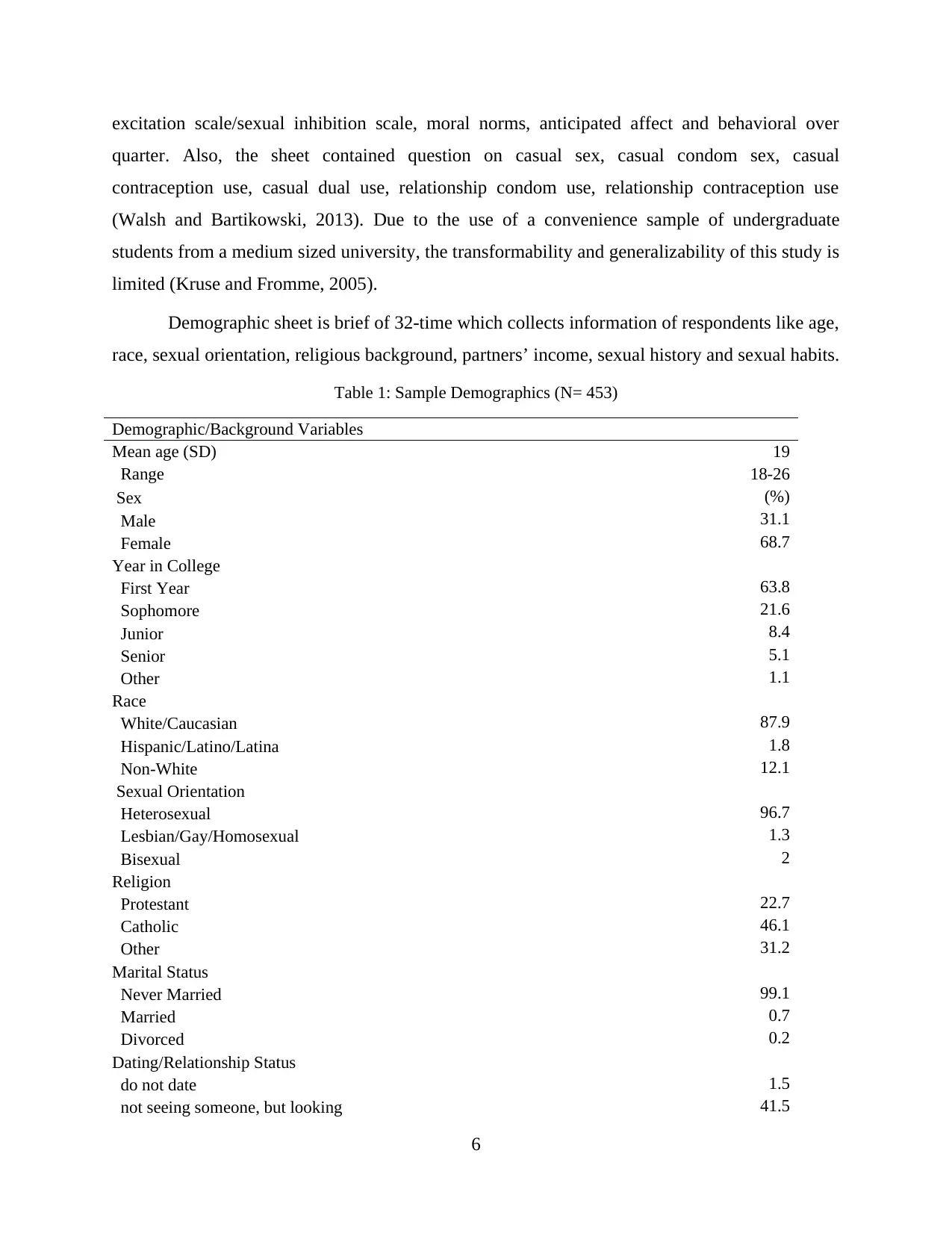
excitation scale/sexual inhibition scale, moral norms, anticipated affect and behavioral over
quarter. Also, the sheet contained question on casual sex, casual condom sex, casual
contraception use, casual dual use, relationship condom use, relationship contraception use
(Walsh and Bartikowski, 2013). Due to the use of a convenience sample of undergraduate
students from a medium sized university, the transformability and generalizability of this study is
limited (Kruse and Fromme, 2005).
Demographic sheet is brief of 32-time which collects information of respondents like age,
race, sexual orientation, religious background, partners’ income, sexual history and sexual habits.
Table 1: Sample Demographics (N= 453)
Demographic/Background Variables
Mean age (SD) 19
Range 18-26
Sex (%)
Male 31.1
Female 68.7
Year in College
First Year 63.8
Sophomore 21.6
Junior 8.4
Senior 5.1
Other 1.1
Race
White/Caucasian 87.9
Hispanic/Latino/Latina 1.8
Non-White 12.1
Sexual Orientation
Heterosexual 96.7
Lesbian/Gay/Homosexual 1.3
Bisexual 2
Religion
Protestant 22.7
Catholic 46.1
Other 31.2
Marital Status
Never Married 99.1
Married 0.7
Divorced 0.2
Dating/Relationship Status
do not date 1.5
not seeing someone, but looking 41.5
6
quarter. Also, the sheet contained question on casual sex, casual condom sex, casual
contraception use, casual dual use, relationship condom use, relationship contraception use
(Walsh and Bartikowski, 2013). Due to the use of a convenience sample of undergraduate
students from a medium sized university, the transformability and generalizability of this study is
limited (Kruse and Fromme, 2005).
Demographic sheet is brief of 32-time which collects information of respondents like age,
race, sexual orientation, religious background, partners’ income, sexual history and sexual habits.
Table 1: Sample Demographics (N= 453)
Demographic/Background Variables
Mean age (SD) 19
Range 18-26
Sex (%)
Male 31.1
Female 68.7
Year in College
First Year 63.8
Sophomore 21.6
Junior 8.4
Senior 5.1
Other 1.1
Race
White/Caucasian 87.9
Hispanic/Latino/Latina 1.8
Non-White 12.1
Sexual Orientation
Heterosexual 96.7
Lesbian/Gay/Homosexual 1.3
Bisexual 2
Religion
Protestant 22.7
Catholic 46.1
Other 31.2
Marital Status
Never Married 99.1
Married 0.7
Divorced 0.2
Dating/Relationship Status
do not date 1.5
not seeing someone, but looking 41.5
6
⊘ This is a preview!⊘
Do you want full access?
Subscribe today to unlock all pages.

Trusted by 1+ million students worldwide
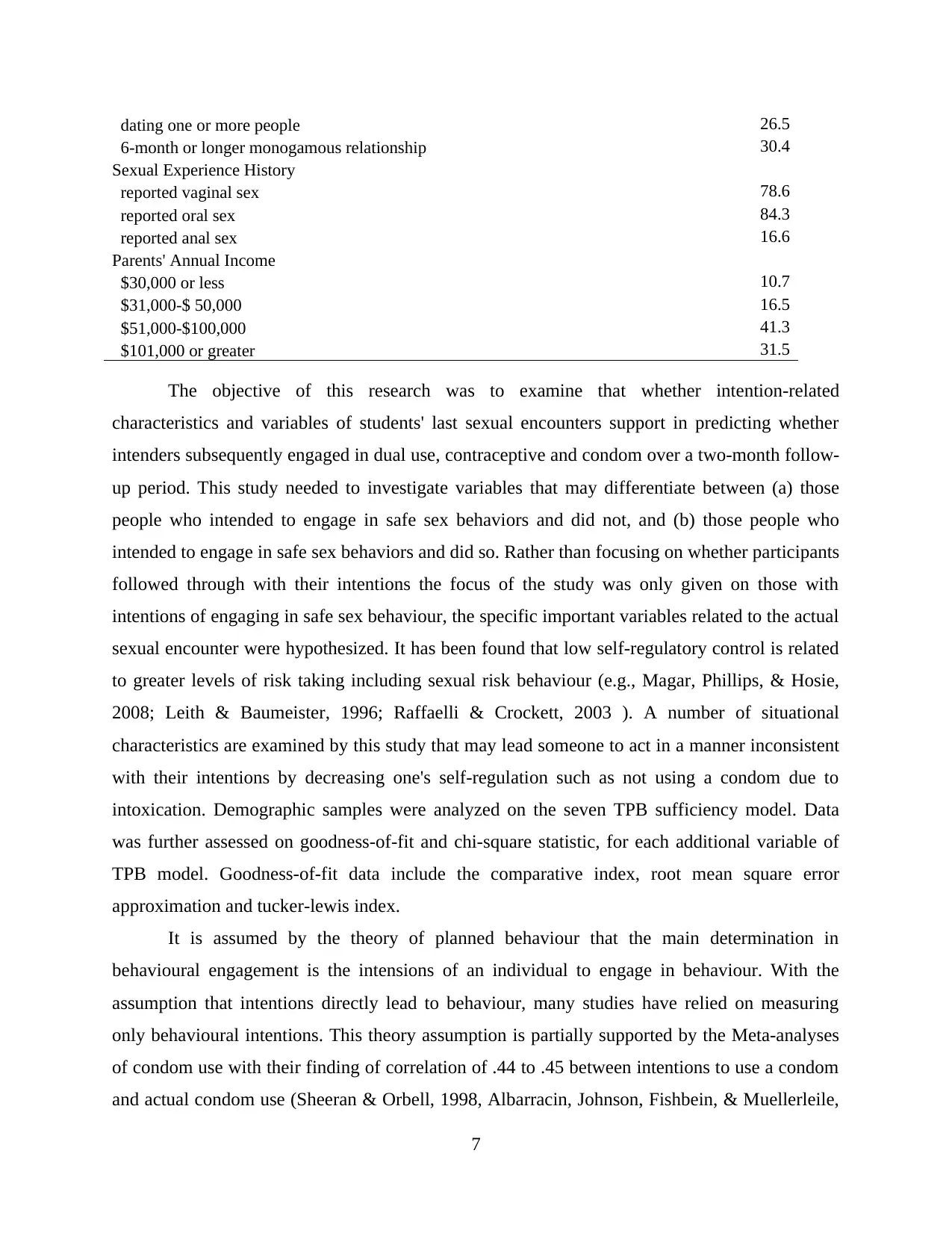
dating one or more people 26.5
6-month or longer monogamous relationship 30.4
Sexual Experience History
reported vaginal sex 78.6
reported oral sex 84.3
reported anal sex 16.6
Parents' Annual Income
$30,000 or less 10.7
$31,000-$ 50,000 16.5
$51,000-$100,000 41.3
$101,000 or greater 31.5
The objective of this research was to examine that whether intention-related
characteristics and variables of students' last sexual encounters support in predicting whether
intenders subsequently engaged in dual use, contraceptive and condom over a two-month follow-
up period. This study needed to investigate variables that may differentiate between (a) those
people who intended to engage in safe sex behaviors and did not, and (b) those people who
intended to engage in safe sex behaviors and did so. Rather than focusing on whether participants
followed through with their intentions the focus of the study was only given on those with
intentions of engaging in safe sex behaviour, the specific important variables related to the actual
sexual encounter were hypothesized. It has been found that low self-regulatory control is related
to greater levels of risk taking including sexual risk behaviour (e.g., Magar, Phillips, & Hosie,
2008; Leith & Baumeister, 1996; Raffaelli & Crockett, 2003 ). A number of situational
characteristics are examined by this study that may lead someone to act in a manner inconsistent
with their intentions by decreasing one's self-regulation such as not using a condom due to
intoxication. Demographic samples were analyzed on the seven TPB sufficiency model. Data
was further assessed on goodness-of-fit and chi-square statistic, for each additional variable of
TPB model. Goodness-of-fit data include the comparative index, root mean square error
approximation and tucker-lewis index.
It is assumed by the theory of planned behaviour that the main determination in
behavioural engagement is the intensions of an individual to engage in behaviour. With the
assumption that intentions directly lead to behaviour, many studies have relied on measuring
only behavioural intentions. This theory assumption is partially supported by the Meta-analyses
of condom use with their finding of correlation of .44 to .45 between intentions to use a condom
and actual condom use (Sheeran & Orbell, 1998, Albarracin, Johnson, Fishbein, & Muellerleile,
7
6-month or longer monogamous relationship 30.4
Sexual Experience History
reported vaginal sex 78.6
reported oral sex 84.3
reported anal sex 16.6
Parents' Annual Income
$30,000 or less 10.7
$31,000-$ 50,000 16.5
$51,000-$100,000 41.3
$101,000 or greater 31.5
The objective of this research was to examine that whether intention-related
characteristics and variables of students' last sexual encounters support in predicting whether
intenders subsequently engaged in dual use, contraceptive and condom over a two-month follow-
up period. This study needed to investigate variables that may differentiate between (a) those
people who intended to engage in safe sex behaviors and did not, and (b) those people who
intended to engage in safe sex behaviors and did so. Rather than focusing on whether participants
followed through with their intentions the focus of the study was only given on those with
intentions of engaging in safe sex behaviour, the specific important variables related to the actual
sexual encounter were hypothesized. It has been found that low self-regulatory control is related
to greater levels of risk taking including sexual risk behaviour (e.g., Magar, Phillips, & Hosie,
2008; Leith & Baumeister, 1996; Raffaelli & Crockett, 2003 ). A number of situational
characteristics are examined by this study that may lead someone to act in a manner inconsistent
with their intentions by decreasing one's self-regulation such as not using a condom due to
intoxication. Demographic samples were analyzed on the seven TPB sufficiency model. Data
was further assessed on goodness-of-fit and chi-square statistic, for each additional variable of
TPB model. Goodness-of-fit data include the comparative index, root mean square error
approximation and tucker-lewis index.
It is assumed by the theory of planned behaviour that the main determination in
behavioural engagement is the intensions of an individual to engage in behaviour. With the
assumption that intentions directly lead to behaviour, many studies have relied on measuring
only behavioural intentions. This theory assumption is partially supported by the Meta-analyses
of condom use with their finding of correlation of .44 to .45 between intentions to use a condom
and actual condom use (Sheeran & Orbell, 1998, Albarracin, Johnson, Fishbein, & Muellerleile,
7
Paraphrase This Document
Need a fresh take? Get an instant paraphrase of this document with our AI Paraphraser
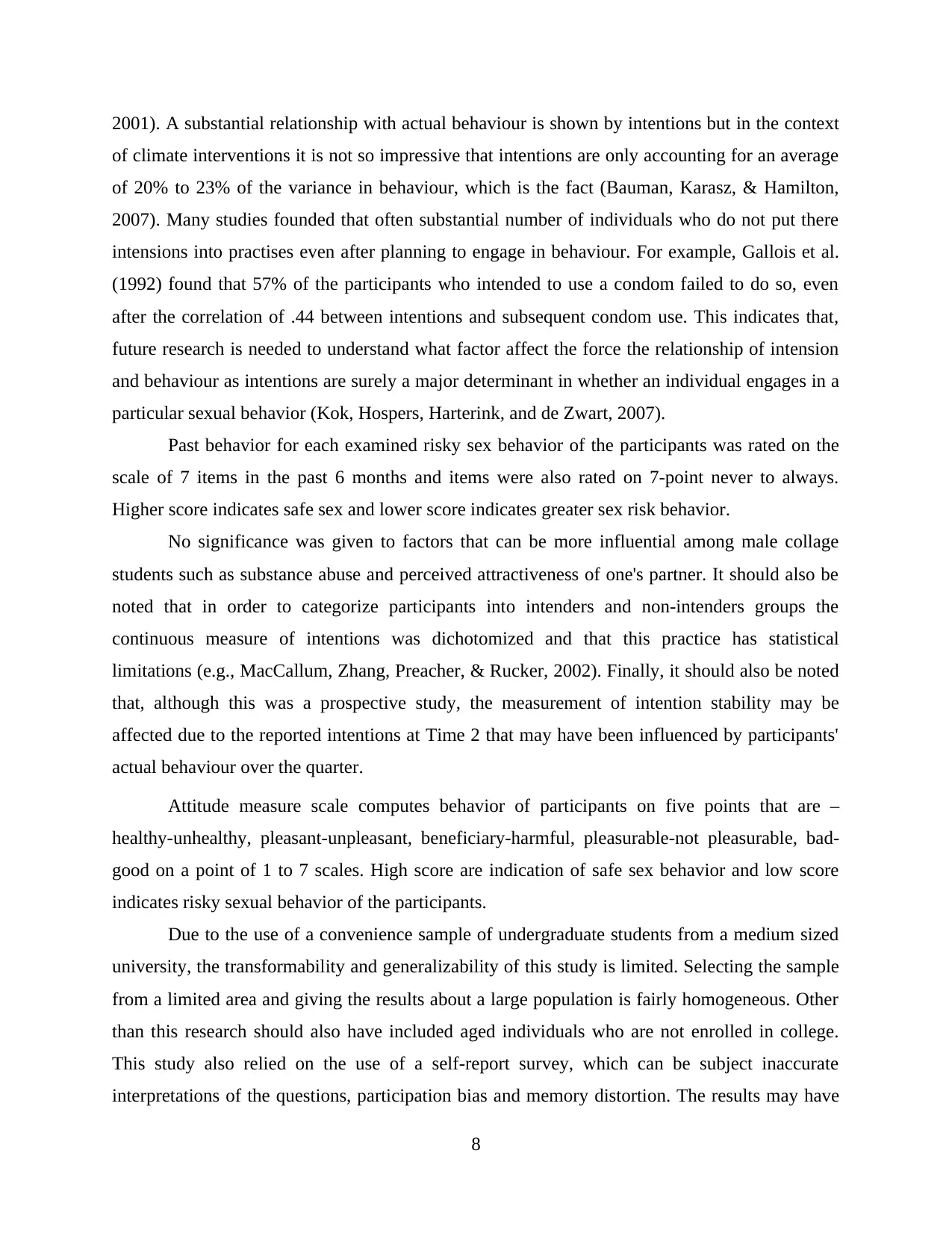
2001). A substantial relationship with actual behaviour is shown by intentions but in the context
of climate interventions it is not so impressive that intentions are only accounting for an average
of 20% to 23% of the variance in behaviour, which is the fact (Bauman, Karasz, & Hamilton,
2007). Many studies founded that often substantial number of individuals who do not put there
intensions into practises even after planning to engage in behaviour. For example, Gallois et al.
(1992) found that 57% of the participants who intended to use a condom failed to do so, even
after the correlation of .44 between intentions and subsequent condom use. This indicates that,
future research is needed to understand what factor affect the force the relationship of intension
and behaviour as intentions are surely a major determinant in whether an individual engages in a
particular sexual behavior (Kok, Hospers, Harterink, and de Zwart, 2007).
Past behavior for each examined risky sex behavior of the participants was rated on the
scale of 7 items in the past 6 months and items were also rated on 7-point never to always.
Higher score indicates safe sex and lower score indicates greater sex risk behavior.
No significance was given to factors that can be more influential among male collage
students such as substance abuse and perceived attractiveness of one's partner. It should also be
noted that in order to categorize participants into intenders and non-intenders groups the
continuous measure of intentions was dichotomized and that this practice has statistical
limitations (e.g., MacCallum, Zhang, Preacher, & Rucker, 2002). Finally, it should also be noted
that, although this was a prospective study, the measurement of intention stability may be
affected due to the reported intentions at Time 2 that may have been influenced by participants'
actual behaviour over the quarter.
Attitude measure scale computes behavior of participants on five points that are –
healthy-unhealthy, pleasant-unpleasant, beneficiary-harmful, pleasurable-not pleasurable, bad-
good on a point of 1 to 7 scales. High score are indication of safe sex behavior and low score
indicates risky sexual behavior of the participants.
Due to the use of a convenience sample of undergraduate students from a medium sized
university, the transformability and generalizability of this study is limited. Selecting the sample
from a limited area and giving the results about a large population is fairly homogeneous. Other
than this research should also have included aged individuals who are not enrolled in college.
This study also relied on the use of a self-report survey, which can be subject inaccurate
interpretations of the questions, participation bias and memory distortion. The results may have
8
of climate interventions it is not so impressive that intentions are only accounting for an average
of 20% to 23% of the variance in behaviour, which is the fact (Bauman, Karasz, & Hamilton,
2007). Many studies founded that often substantial number of individuals who do not put there
intensions into practises even after planning to engage in behaviour. For example, Gallois et al.
(1992) found that 57% of the participants who intended to use a condom failed to do so, even
after the correlation of .44 between intentions and subsequent condom use. This indicates that,
future research is needed to understand what factor affect the force the relationship of intension
and behaviour as intentions are surely a major determinant in whether an individual engages in a
particular sexual behavior (Kok, Hospers, Harterink, and de Zwart, 2007).
Past behavior for each examined risky sex behavior of the participants was rated on the
scale of 7 items in the past 6 months and items were also rated on 7-point never to always.
Higher score indicates safe sex and lower score indicates greater sex risk behavior.
No significance was given to factors that can be more influential among male collage
students such as substance abuse and perceived attractiveness of one's partner. It should also be
noted that in order to categorize participants into intenders and non-intenders groups the
continuous measure of intentions was dichotomized and that this practice has statistical
limitations (e.g., MacCallum, Zhang, Preacher, & Rucker, 2002). Finally, it should also be noted
that, although this was a prospective study, the measurement of intention stability may be
affected due to the reported intentions at Time 2 that may have been influenced by participants'
actual behaviour over the quarter.
Attitude measure scale computes behavior of participants on five points that are –
healthy-unhealthy, pleasant-unpleasant, beneficiary-harmful, pleasurable-not pleasurable, bad-
good on a point of 1 to 7 scales. High score are indication of safe sex behavior and low score
indicates risky sexual behavior of the participants.
Due to the use of a convenience sample of undergraduate students from a medium sized
university, the transformability and generalizability of this study is limited. Selecting the sample
from a limited area and giving the results about a large population is fairly homogeneous. Other
than this research should also have included aged individuals who are not enrolled in college.
This study also relied on the use of a self-report survey, which can be subject inaccurate
interpretations of the questions, participation bias and memory distortion. The results may have
8
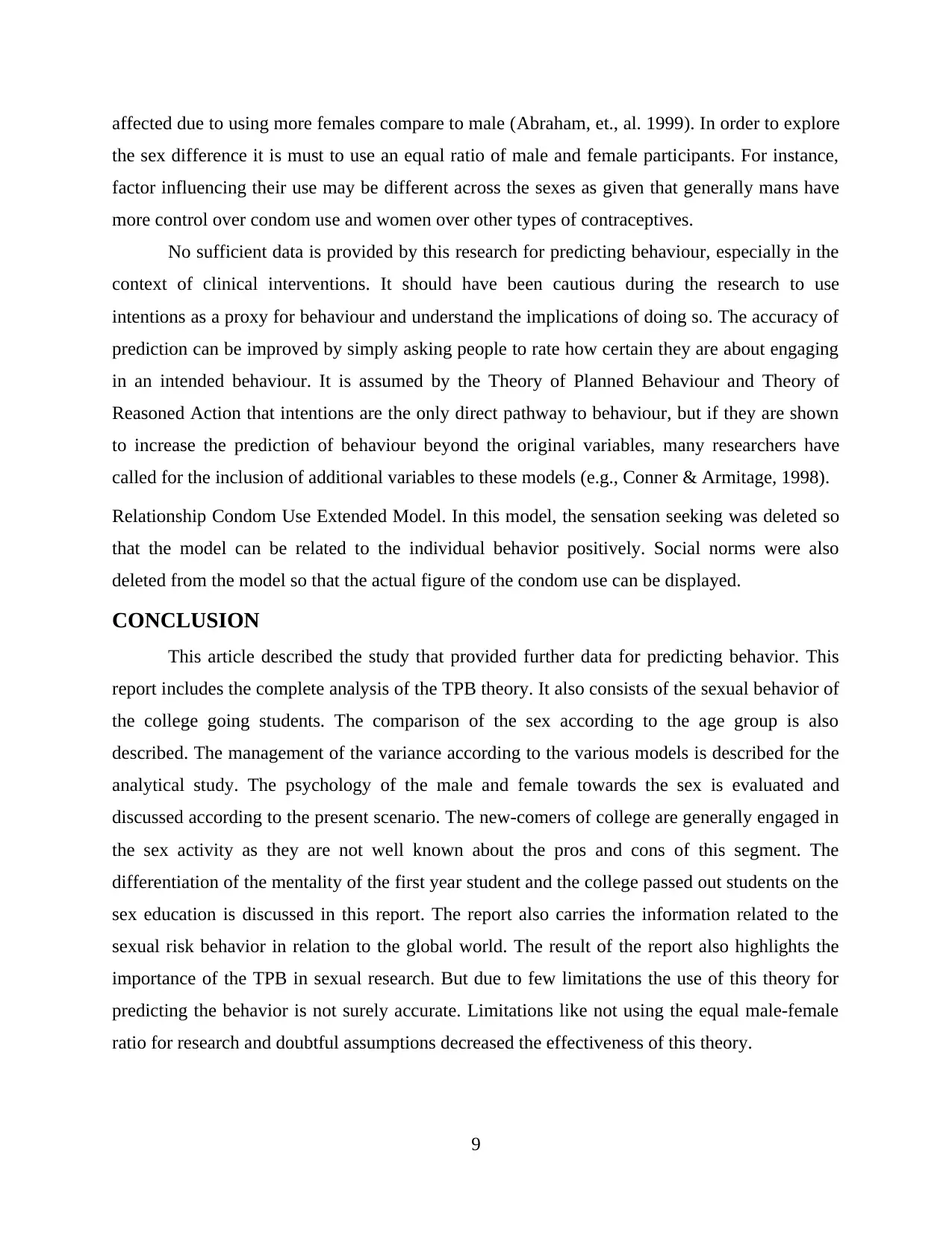
affected due to using more females compare to male (Abraham, et., al. 1999). In order to explore
the sex difference it is must to use an equal ratio of male and female participants. For instance,
factor influencing their use may be different across the sexes as given that generally mans have
more control over condom use and women over other types of contraceptives.
No sufficient data is provided by this research for predicting behaviour, especially in the
context of clinical interventions. It should have been cautious during the research to use
intentions as a proxy for behaviour and understand the implications of doing so. The accuracy of
prediction can be improved by simply asking people to rate how certain they are about engaging
in an intended behaviour. It is assumed by the Theory of Planned Behaviour and Theory of
Reasoned Action that intentions are the only direct pathway to behaviour, but if they are shown
to increase the prediction of behaviour beyond the original variables, many researchers have
called for the inclusion of additional variables to these models (e.g., Conner & Armitage, 1998).
Relationship Condom Use Extended Model. In this model, the sensation seeking was deleted so
that the model can be related to the individual behavior positively. Social norms were also
deleted from the model so that the actual figure of the condom use can be displayed.
CONCLUSION
This article described the study that provided further data for predicting behavior. This
report includes the complete analysis of the TPB theory. It also consists of the sexual behavior of
the college going students. The comparison of the sex according to the age group is also
described. The management of the variance according to the various models is described for the
analytical study. The psychology of the male and female towards the sex is evaluated and
discussed according to the present scenario. The new-comers of college are generally engaged in
the sex activity as they are not well known about the pros and cons of this segment. The
differentiation of the mentality of the first year student and the college passed out students on the
sex education is discussed in this report. The report also carries the information related to the
sexual risk behavior in relation to the global world. The result of the report also highlights the
importance of the TPB in sexual research. But due to few limitations the use of this theory for
predicting the behavior is not surely accurate. Limitations like not using the equal male-female
ratio for research and doubtful assumptions decreased the effectiveness of this theory.
9
the sex difference it is must to use an equal ratio of male and female participants. For instance,
factor influencing their use may be different across the sexes as given that generally mans have
more control over condom use and women over other types of contraceptives.
No sufficient data is provided by this research for predicting behaviour, especially in the
context of clinical interventions. It should have been cautious during the research to use
intentions as a proxy for behaviour and understand the implications of doing so. The accuracy of
prediction can be improved by simply asking people to rate how certain they are about engaging
in an intended behaviour. It is assumed by the Theory of Planned Behaviour and Theory of
Reasoned Action that intentions are the only direct pathway to behaviour, but if they are shown
to increase the prediction of behaviour beyond the original variables, many researchers have
called for the inclusion of additional variables to these models (e.g., Conner & Armitage, 1998).
Relationship Condom Use Extended Model. In this model, the sensation seeking was deleted so
that the model can be related to the individual behavior positively. Social norms were also
deleted from the model so that the actual figure of the condom use can be displayed.
CONCLUSION
This article described the study that provided further data for predicting behavior. This
report includes the complete analysis of the TPB theory. It also consists of the sexual behavior of
the college going students. The comparison of the sex according to the age group is also
described. The management of the variance according to the various models is described for the
analytical study. The psychology of the male and female towards the sex is evaluated and
discussed according to the present scenario. The new-comers of college are generally engaged in
the sex activity as they are not well known about the pros and cons of this segment. The
differentiation of the mentality of the first year student and the college passed out students on the
sex education is discussed in this report. The report also carries the information related to the
sexual risk behavior in relation to the global world. The result of the report also highlights the
importance of the TPB in sexual research. But due to few limitations the use of this theory for
predicting the behavior is not surely accurate. Limitations like not using the equal male-female
ratio for research and doubtful assumptions decreased the effectiveness of this theory.
9
⊘ This is a preview!⊘
Do you want full access?
Subscribe today to unlock all pages.

Trusted by 1+ million students worldwide
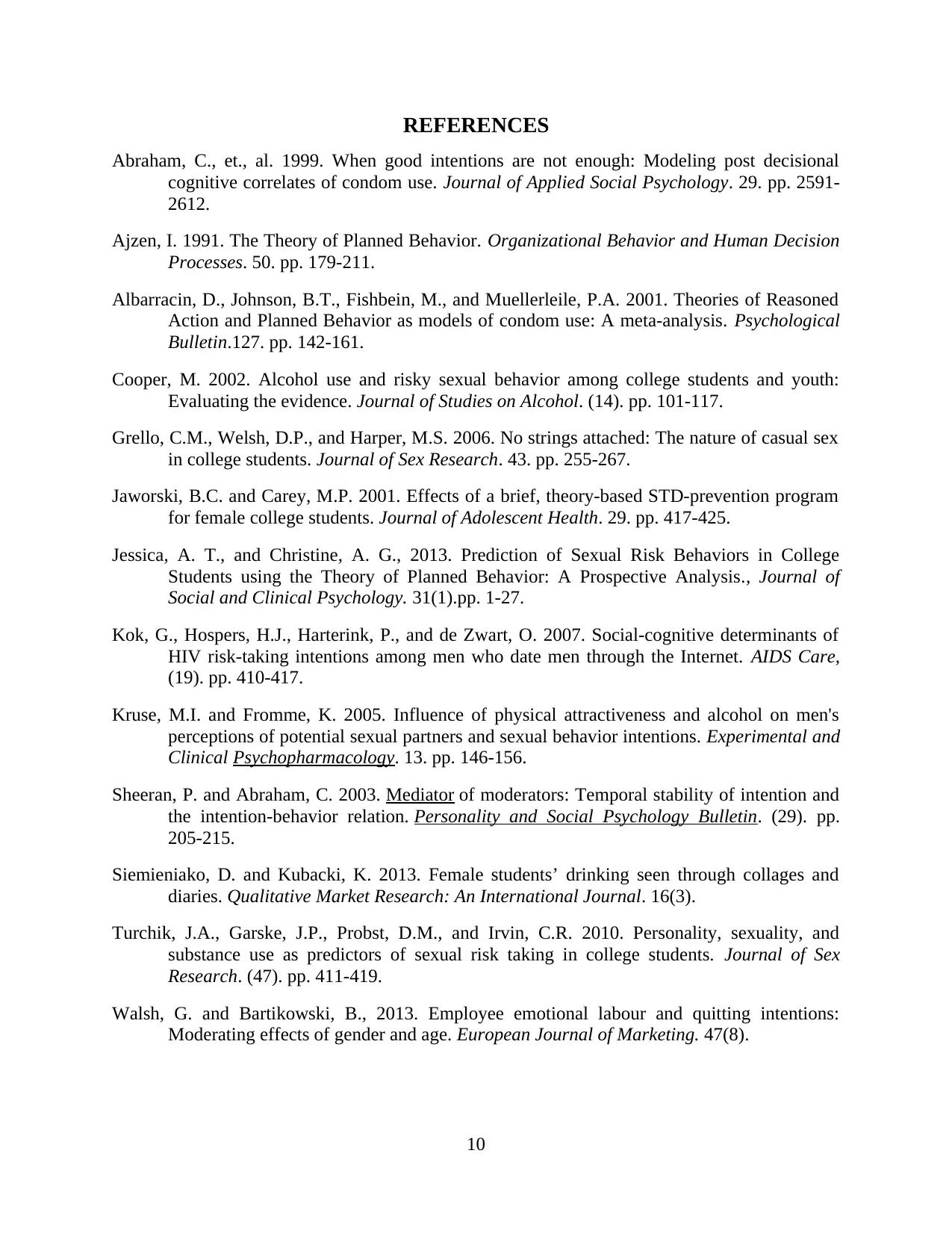
REFERENCES
Abraham, C., et., al. 1999. When good intentions are not enough: Modeling post decisional
cognitive correlates of condom use. Journal of Applied Social Psychology. 29. pp. 2591-
2612.
Ajzen, I. 1991. The Theory of Planned Behavior. Organizational Behavior and Human Decision
Processes. 50. pp. 179-211.
Albarracin, D., Johnson, B.T., Fishbein, M., and Muellerleile, P.A. 2001. Theories of Reasoned
Action and Planned Behavior as models of condom use: A meta-analysis. Psychological
Bulletin.127. pp. 142-161.
Cooper, M. 2002. Alcohol use and risky sexual behavior among college students and youth:
Evaluating the evidence. Journal of Studies on Alcohol. (14). pp. 101-117.
Grello, C.M., Welsh, D.P., and Harper, M.S. 2006. No strings attached: The nature of casual sex
in college students. Journal of Sex Research. 43. pp. 255-267.
Jaworski, B.C. and Carey, M.P. 2001. Effects of a brief, theory-based STD-prevention program
for female college students. Journal of Adolescent Health. 29. pp. 417-425.
Jessica, A. T., and Christine, A. G., 2013. Prediction of Sexual Risk Behaviors in College
Students using the Theory of Planned Behavior: A Prospective Analysis., Journal of
Social and Clinical Psychology. 31(1).pp. 1-27.
Kok, G., Hospers, H.J., Harterink, P., and de Zwart, O. 2007. Social-cognitive determinants of
HIV risk-taking intentions among men who date men through the Internet. AIDS Care,
(19). pp. 410-417.
Kruse, M.I. and Fromme, K. 2005. Influence of physical attractiveness and alcohol on men's
perceptions of potential sexual partners and sexual behavior intentions. Experimental and
Clinical Psychopharmacology. 13. pp. 146-156.
Sheeran, P. and Abraham, C. 2003. Mediator of moderators: Temporal stability of intention and
the intention-behavior relation. Personality and Social Psychology Bulletin. (29). pp.
205-215.
Siemieniako, D. and Kubacki, K. 2013. Female students’ drinking seen through collages and
diaries. Qualitative Market Research: An International Journal. 16(3).
Turchik, J.A., Garske, J.P., Probst, D.M., and Irvin, C.R. 2010. Personality, sexuality, and
substance use as predictors of sexual risk taking in college students. Journal of Sex
Research. (47). pp. 411-419.
Walsh, G. and Bartikowski, B., 2013. Employee emotional labour and quitting intentions:
Moderating effects of gender and age. European Journal of Marketing. 47(8).
10
Abraham, C., et., al. 1999. When good intentions are not enough: Modeling post decisional
cognitive correlates of condom use. Journal of Applied Social Psychology. 29. pp. 2591-
2612.
Ajzen, I. 1991. The Theory of Planned Behavior. Organizational Behavior and Human Decision
Processes. 50. pp. 179-211.
Albarracin, D., Johnson, B.T., Fishbein, M., and Muellerleile, P.A. 2001. Theories of Reasoned
Action and Planned Behavior as models of condom use: A meta-analysis. Psychological
Bulletin.127. pp. 142-161.
Cooper, M. 2002. Alcohol use and risky sexual behavior among college students and youth:
Evaluating the evidence. Journal of Studies on Alcohol. (14). pp. 101-117.
Grello, C.M., Welsh, D.P., and Harper, M.S. 2006. No strings attached: The nature of casual sex
in college students. Journal of Sex Research. 43. pp. 255-267.
Jaworski, B.C. and Carey, M.P. 2001. Effects of a brief, theory-based STD-prevention program
for female college students. Journal of Adolescent Health. 29. pp. 417-425.
Jessica, A. T., and Christine, A. G., 2013. Prediction of Sexual Risk Behaviors in College
Students using the Theory of Planned Behavior: A Prospective Analysis., Journal of
Social and Clinical Psychology. 31(1).pp. 1-27.
Kok, G., Hospers, H.J., Harterink, P., and de Zwart, O. 2007. Social-cognitive determinants of
HIV risk-taking intentions among men who date men through the Internet. AIDS Care,
(19). pp. 410-417.
Kruse, M.I. and Fromme, K. 2005. Influence of physical attractiveness and alcohol on men's
perceptions of potential sexual partners and sexual behavior intentions. Experimental and
Clinical Psychopharmacology. 13. pp. 146-156.
Sheeran, P. and Abraham, C. 2003. Mediator of moderators: Temporal stability of intention and
the intention-behavior relation. Personality and Social Psychology Bulletin. (29). pp.
205-215.
Siemieniako, D. and Kubacki, K. 2013. Female students’ drinking seen through collages and
diaries. Qualitative Market Research: An International Journal. 16(3).
Turchik, J.A., Garske, J.P., Probst, D.M., and Irvin, C.R. 2010. Personality, sexuality, and
substance use as predictors of sexual risk taking in college students. Journal of Sex
Research. (47). pp. 411-419.
Walsh, G. and Bartikowski, B., 2013. Employee emotional labour and quitting intentions:
Moderating effects of gender and age. European Journal of Marketing. 47(8).
10
1 out of 10
Related Documents
Your All-in-One AI-Powered Toolkit for Academic Success.
+13062052269
info@desklib.com
Available 24*7 on WhatsApp / Email
![[object Object]](/_next/static/media/star-bottom.7253800d.svg)
Unlock your academic potential
Copyright © 2020–2025 A2Z Services. All Rights Reserved. Developed and managed by ZUCOL.



